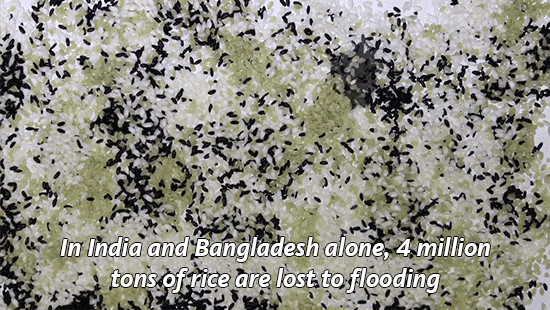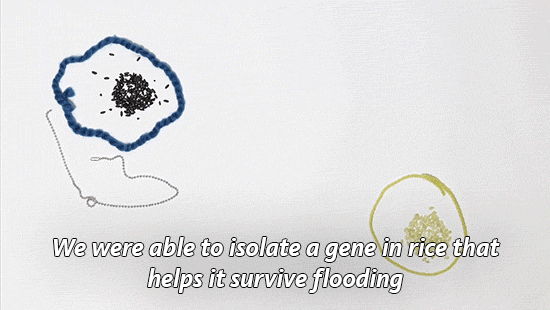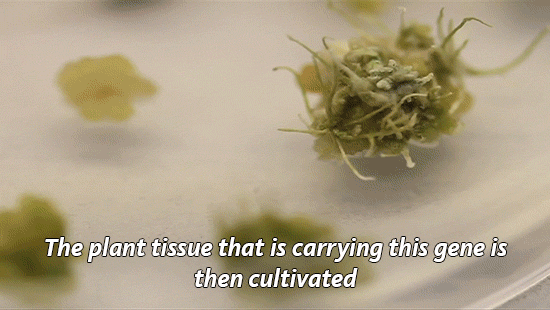Blowing Bubbles In The Gamma-ray Sky
Blowing Bubbles in the Gamma-ray Sky

Did you know our Milky Way galaxy is blowing bubbles? Two of them, each 25,000 light-years tall! They extend above and below the disk of the galaxy, like the two halves of an hourglass. We can’t see them with our own eyes because they’re only apparent in gamma-ray light, the highest-energy light in the universe.

We didn’t even know these humongous structures were smack in the middle of our galaxy until 2010. Scientists found them when they analyzed the first two years of data from NASA’s Fermi Gamma-ray Space Telescope. They dubbed them the “Fermi bubbles” and found that in addition to being really big and spread out, they seem to have well-defined edges. The bubbles’ shape and the light they give off led scientists to think they were created by a rapid release of energy. But by what? And when?

One possible explanation is that they could be leftovers from the last big meal eaten by the supermassive black hole at the center of our galaxy. This monster is more than 4 million times the mass of our own Sun. Scientists think it may have slurped up a big cloud of hydrogen between 6 and 9 million years ago and then burped jets of hot gas that we see in gamma rays and X-rays.

Another possible explanation is that the bubbles could be the remains of star formation. There are massive clusters of stars at very the center of the Milky Way — sometimes the stars are so closely packed they’re a million times more dense than in the outer suburb of the galaxy where we live. If there was a burst of star formation in this area a few million years ago, it could have created the surge of gas needed to in turn create the Fermi bubbles.

It took us until 2010 to see these Fermi bubbles because the sky is filled with a fog of other gamma rays that can obscure our view. This fog is created when particles moving near light speed bump into gas, dust, and light in the Milky Way. These collisions produce gamma rays, and scientists had to factor out the fog to unveil the bubbles.

Scientists continue to study the possible causes of these massive bubbles using the 10 years of data Fermi has collected so far. Fermi has also made many other exciting discoveries — like the the collision of superdense neutron stars and the nature of space-time. Learn more about Fermi and how we’ve been celebrating its first decade in space.
Make sure to follow us on Tumblr for your regular dose of space: http://nasa.tumblr.com
More Posts from Science-is-magical and Others
Good news today: the fastest horizontal flyer in the animal kingdom is now a bat.
Free-tailed bats have now been clocked flying horizontally at over 160 kilometers per hour (that’s nearly 100 mph!), toppling the previous record-holder, the swift. The record for speed of diving is still held by the peregrine falcon but we’re coming for you next, feathers.
Source
So they found this adorable little dinosaur called Anchiornis


See those feathers? The skeleton they found was so well-preserved that scientists were able to examine the pigment cells in the feathers and compare them to those of modern day birds.
And they were able to do this with such accuracy that they know the coloration of this dinosaur. In life it looked something like this.

It just baffles me that we know the color patterns of an animal that has been dead for 161 million years
Here are 17 jaw-dropping photos of space that show us just how small we really are:
This photo of the moon and Earth taken from the International Space Station.

A dwarf galaxy, about 11 million light-years away from us.

Earth as seen from the moon in 1968.

A cluster of stars, 20,000 light-years away from Earth.

The first flower grown in the International Space Station, photographed by astronaut Scott Kelly.

Saturn, seen through an infared filter.

These visible “loops” on the surface of the sun can reach up to 15 times the diameter of Earth in height.

The Northen Lights just North of Chicago, viewed from the International Space Station.

The Quintuplet Cluster, located 100 light-years from the center of our galaxy.

Pluto and one of its moons, Charon.

The Great Pyramids of Giza, seen from space.

Astronaut Bruce McCandless maneuvering, untethered, above Earth in 1984.

Galaxy NGC 6240, 400 million light-years away from Earth.

Palomar 12, a cluster of stars on the outskirts of the Milky Way.

The remnants of an exploded star.

New York City, seen from the International Space Station.

And the remains of a supernova whose explosion may have been seen almost 2,000 years ago by Chinese astronomers.
Follow @the-future-now

As Ars has reported previously, scientists have found that triclosan and other antimicrobial soaps have little benefit to consumers and may actually pose risks. These include bolstering antibiotic resistant microbes, giving opportunistic pathogens a leg up, and disrupting microbiomes. In its final ruling, issued Friday, the FDA seemed to agree. “Consumers may think antibacterial washes are more effective at preventing the spread of germs, but we have no scientific evidence that they are any better than plain soap and water,” Janet Woodcock, director of the FDA’s Center for Drug Evaluation and Research (CDER), said in a statement. “In fact, some data suggests that antibacterial ingredients may do more harm than good over the long-term.”
[…]
The ruling does not affect alcohol-based hand sanitizers or wipes, which the agency is reviewing separately. It also does not affect antiseptic products used in healthcare settings.
Asteroid Terms: Explained
There are interesting asteroid characters in our solar system, including an asteroid that has its own moon and even one that is shaped like a dog bone! Our OSIRIS-REx mission launches at 7:05 p.m. EDT today and will travel to asteroid Bennu.

Scientists chose Bennu as the target of the OSIRIS-REx mission because of its composition, size and proximity to Earth. Bennu is a rare B-type asteroid (primitive and carbon-rich), which is expected to have organic compounds and water-bearing minerals like clays.
Our OSIRIS-REx mission will travel to Bennu and bring a small sample back to Earth for study.

When talking about asteroids, there are some terms scientists use that might not be in your typical vocabulary…but we’ll help with that!
Here are a few terms you should know:
Orbital Eccentricity: This number describes the shape of an asteroid’s orbit by how elliptical it is. For asteroids in orbit around the sun, eccentricity is a number between 0 and 1, with 0 being a perfectly circular orbit and 0.99 being a highly elliptical orbit.
Inclination: The angle, in degrees, of how tilted an asteroid’s orbit is compared to another plane of reference, usually the plane of the Earth’s orbit around the sun.
Orbital Period: The number of days it takes for an asteroid to revolve once around the sun. For example, the Earth’s orbital period is 365 days.
Perihelion Distance: The distance between an asteroid and the sun when the asteroid is closest to the sun.
Aphelion Distance: The distance between the asteroid and the sun when the asteroid is farthest away from the sun.
Astronomical unit: A distance unit commonly used to describe orbits of objects around the sun. The distance from the Earth to the sun is one astronomical unit, or 1 AU, equivalent to about 93 million miles or 150 million kilometers.
Diameter: A measure of the size of an asteroid. It is the length of a line from a point on the surface, through the center of the asteroid, extending out to the opposite surface. Irregularly shaped asteroids may have different diameters depending on which direction they are measured.
Rotation Period: The time it takes for an asteroid to complete one revolution around its axis of rotation. For example, the rotation period of the Earth is approximately 24 hours, or 1 day.
Spectral Type: The classification of an asteroid, based on a measurement of the light reflected by the asteroid.

Watch live launch coverage of OSIRIS-REx to asteroid Bennu starting at 5:30 p.m, on NASA TV: http://www.nasa.gov/nasatv
Make sure to follow us on Tumblr for your regular dose of space: http://nasa.tumblr.com


It’s officially starry scholastic month!
Planet X starts off with a quick science fact!
Planet X’s first lesson will be posted tonight!
Today’s starry Fact: Niku
http://www.popularmechanics.com/space/deep-space/a22293/niku-weird-object-beyond-neptune/
It always creeps me out...
…that no matter

how close

you get

the pupil

seems to

devour light

like a black hole

it reflects no light




Why we need GMOs to survive climate change
Genetically modified organisms get a bad rap for many reasons, but we’ve actually been genetically altering what we eat since the dawn of human history.
“For 10,000 years, we have altered the genetic makeup of our crops,”explains UC Davis plant pathology professor Pamela Ronald.
“Today virtually everything we eat is produced from seeds that we have genetically altered in one way or another.” (You can read more about Ronald’s thoughts on genetically engineered food here.)
Right now her focus is on rice. It’s one of our basic crops and without it, we would struggle to feed much of the world.
With climate change, we’re seeing an increase in flooding in places like India and Bangladesh, which makes it harder to grow this important food staple.
So Ronald and her lab have developed a flood-tolerant strain of rice. It’s known as Sub1a or “scuba rice” and millions of farmers in South Asia are now growing it in their fields.

Today is National Food Day, a day dedicated to hunger awareness. But as we focus on food insecurity, we need to talk more about how global warming will make the problem worse.
As our climate continues to heat up, it has huge impacts on what foods we are able to grow. Will our crops be able to survive droughts and floods? The University of California leads six labs that are working to develop other climate-resilient crops including chickpea, cowpea and millet.
Find out what other scientists are doing to improve our food.
-
 sahirah111 reblogged this · 5 months ago
sahirah111 reblogged this · 5 months ago -
 sahirah111 liked this · 5 months ago
sahirah111 liked this · 5 months ago -
 perriagade liked this · 1 year ago
perriagade liked this · 1 year ago -
 thomasbrisenio liked this · 2 years ago
thomasbrisenio liked this · 2 years ago -
 soondaebyul liked this · 2 years ago
soondaebyul liked this · 2 years ago -
 crimsonhobbit liked this · 2 years ago
crimsonhobbit liked this · 2 years ago -
 luchre liked this · 3 years ago
luchre liked this · 3 years ago -
 tikalovesgalaxy liked this · 3 years ago
tikalovesgalaxy liked this · 3 years ago -
 warrior-of-the-blue-moon reblogged this · 3 years ago
warrior-of-the-blue-moon reblogged this · 3 years ago -
 warrior-of-the-blue-moon liked this · 3 years ago
warrior-of-the-blue-moon liked this · 3 years ago -
 whispering-imp reblogged this · 3 years ago
whispering-imp reblogged this · 3 years ago -
 whispering-imp liked this · 3 years ago
whispering-imp liked this · 3 years ago -
 ehsunassadi liked this · 4 years ago
ehsunassadi liked this · 4 years ago -
 edanziylz liked this · 4 years ago
edanziylz liked this · 4 years ago -
 im-nike-1111 reblogged this · 4 years ago
im-nike-1111 reblogged this · 4 years ago -
 im-nike-1111 liked this · 4 years ago
im-nike-1111 liked this · 4 years ago -
 science-is-magical reblogged this · 4 years ago
science-is-magical reblogged this · 4 years ago -
 honeysforskog liked this · 5 years ago
honeysforskog liked this · 5 years ago -
 sloanarp-blog liked this · 5 years ago
sloanarp-blog liked this · 5 years ago -
 patrickefoni liked this · 5 years ago
patrickefoni liked this · 5 years ago -
 suzeranity liked this · 5 years ago
suzeranity liked this · 5 years ago -
 rockinashy liked this · 6 years ago
rockinashy liked this · 6 years ago -
 alex5791 reblogged this · 6 years ago
alex5791 reblogged this · 6 years ago -
 viiscariaa liked this · 6 years ago
viiscariaa liked this · 6 years ago -
 fuck-these-hoes liked this · 6 years ago
fuck-these-hoes liked this · 6 years ago -
 discountcatfood liked this · 6 years ago
discountcatfood liked this · 6 years ago -
 shawn1965 liked this · 6 years ago
shawn1965 liked this · 6 years ago -
 paulom110 reblogged this · 6 years ago
paulom110 reblogged this · 6 years ago -
 paulom110 liked this · 6 years ago
paulom110 liked this · 6 years ago -
 sebachemu liked this · 6 years ago
sebachemu liked this · 6 years ago





